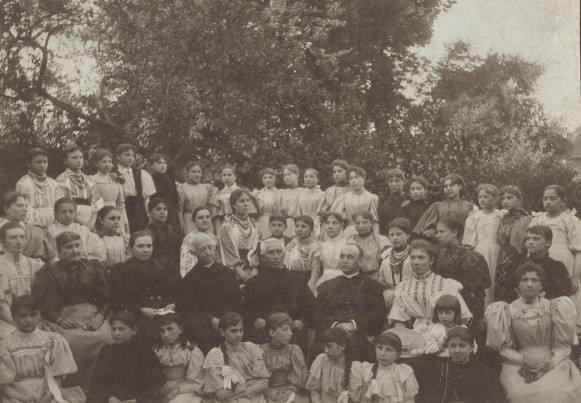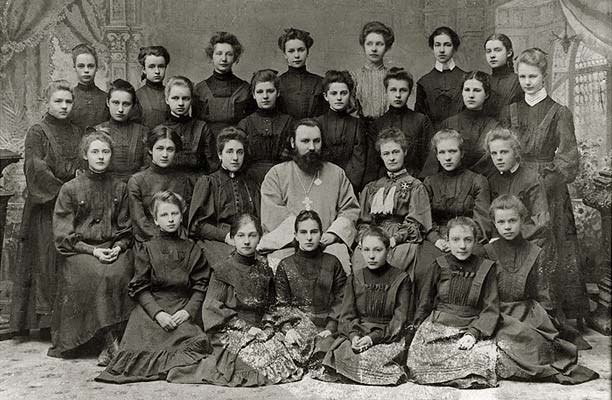Education of women
Education of women. Information on education for girls and women prior to the 18th century is fragmentary. It is known that it was originally associated with monastery schools, where women were taught writing, religious knowledge, and singing. The earliest known of such schools was the girls' school established in 1088 by Princess Anna Vsevolodivna at Saint Andrew’s Monastery in Kyiv. A 17th-century traveler, Paul of Aleppo, testified to the high standard of education attained by women. The daughters of the Cossack starshyna received instruction in monastery schools or from private tutors.
In those areas of Ukraine that were incorporated into the Russian Empire some girls attended parochial schools and later zemstvo schools in the villages, or county schools in the towns. A high proportion of girls went to Sunday schools, which were established in the 1850s–1860s in the towns throughout Ukraine by the Ukrainian intelligentsia. Some of these schools were designed only for girls. After the school reforms of the 1860s the elementary schools in the villages were coeducational; in the towns they were usually segregated by sex. However, in 1897 scarcely 11.2 percent of females over the age of five in Ukraine were literate (compared to 34.2 percent of males).
The finishing institutes for daughters of the nobility were the first secondary schools for women in Russian-ruled Ukraine. Their purpose was to develop devout and patriotic women. Such institutions were established in Kharkiv (1812), Poltava (1817), Odesa (1829), and Kyiv (1838). The language of instruction was often French, and the curriculum included such subjects as literature, history, and foreign languages.
Many daughters of Ukrainian nobles were educated at private boarding schools for girls, which were usually run by foreigners, mostly French and Germans. Such schools became established in Russia in the first decades of the 19th century. In the mid-19th century gymnasiums for women began to open, and in a short while they became the main type of secondary school for women. The first such gymnasium in Ukraine was established in Kyiv in 1850. The lower type of gymnasium—the junior gymnasium—had a four-year program, while the higher type had a seven-year program. An additional eighth grade provided pedagogical training for teachers of public schools. The program for women was not as demanding as that in the men’s gymnasiums (classical languages were not required), although some private women’s gymnasiums were on a par with those for men. The seven-year eparchial schools for daughters of the clergy had the same program as the gymnasiums. On 1 January 1919 there were 362 women’s gymnasiums in Ukraine, 4 women's institutes, and 15 eparchial schools. Until the Revolution of 1917 Russian was the language of instruction in elementary schools and secondary schools. At the end of the 19th century secondary vocational schools, co-educational commercial schools, dental schools, obstetrical schools, and other schools were opened.
Higher education was closed to women for a long time. Only in 1860 did women gain the right to study at universities in Ukraine, and this was revoked two years later. The first higher educational institution for women in Ukraine, the Higher Courses for Women, was established at Kyiv University in 1878. It was closed down by the authorities in 1886. A number of higher schools for women were set up only after the Revolution of 1905, notably Saint Olha's Women's Institute, the private courses of Mme Zhekulina in Kyiv, and a school founded by the Association of Working Women in Kharkiv. They had a four-year program, with standard departments of physics and mathematics, history and philology, and jurisprudence. Some of them also had departments of economics and medicine. In 1912 their enrollment numbered more than 4,000 students. By 1915 there were also the following higher professional schools for women: women's medical institutes in Kyiv, Kharkiv, and Odesa; the Women's Polytechnical Institute in Kharkiv; and the Froebelian Pedagogical Courses in Kharkiv. The universities were again open to women briefly in 1906–9.
The Revolution of 1917 gave women an equal right to education and made schools co-educational at every level. Russian was replaced by Ukrainian as the language of instruction, usually quite abruptly but sometimes gradually. As the network of schools expanded and elementary schooling became universal in 1930 (see Compulsory universal education), literacy among women increased steadily. The literacy rate for women in Soviet Ukraine was 37.1 percent (it was 32.5 percent for Ukrainian-speaking women) in 1926 and 72 percent in 1939; it is close to 100 percent today. The percentage of women with a secondary education (6.8 percent compared to 8.9 percent for men in 1939) and higher education has increased steadily. Before the Revolution of 1917 women accounted for only 10 percent of the students at institutions of higher education. By 1928 they accounted for 26 percent, in 1936 for 38 percent, in 1955 for 42.9 percent, and in 1979 for 51.7 percent. Among students at special secondary schools (see Secondary special education) girls accounted for 47.2 percent in 1956 and for 55.3 percent in 1979.
In Galicia and Bukovyna under the Austrian regime, the school reforms of the 1860s introduced universal education with co-educational lower schools in the villages, but segregated higher schools in the towns. Several private Ukrainian elementary schools were opened in the towns, including girls' schools. In 1898, for example, the Shevchenko Elementary School for Girls was founded in Lviv.
The first secondary schools for women in Galicia were Polish private lyceums with a six-year program. The first Ukrainian school of this type was the lyceum established in Peremyshl in the 1890s (see Ukrainian Girls' Institute in Peremyshl). The first private gymnasiums for women were founded only in the 1890s in Lviv, with Polish as the language of instruction. The first Ukrainian gymnasium for women was opened by the Basilian order of nuns in Lviv in 1906. In Bukovyna women attended Ukrainian co-educational gymnasiums in Chernivtsi, Vyzhnytsia, and Kitsman. A larger proportion of Ukrainian women studied at teachers' seminaries, which provided them with not only an education but also a profession. The first teachers' seminaries were founded in the 1870s in Lviv and Chernivtsi. By the 1910s there were three state teachers' seminaries, which were bilingual (Ukrainian-Polish), and one private one in Yavoriv. In Bukovyna there was one state and one private teachers' seminary. In 1900 women were admitted to universities in the Austro-Hungarian Empire by law. In Ukrainian territories under the Polish regime education for women expanded in the 1920s–1930s despite a strong policy of Polonization. The literacy rate among women in Western Ukraine rose from 44.4 percent in 1921 to 56 percent in 1931. Secondary education and vocational education for women grew with particular rapidity. In 1939, of 27 Ukrainian gymnasiums in Poland, 7 were for women, 7 for men, and 13 were co-educational. The Nursery Teachers' Seminary, established in Lviv in 1934, was meant particularly for women.
Under the German occupation professional education, particularly pedagogical education for women (women constituted 60 percent of the enrollment at teachers' seminaries), expanded greatly in the Generalgouvernement, especially in Galicia. However, the number of women enrolled in gymnasiums fell to 20 percent.
In Bukovyna, in addition to a girls' gymnasium and a teachers' seminary, there was also a trade school, which provided a general education and taught tailoring and home economics.
The education of women made great progress in Transcarpathia because of its coeducational system. There was, however, a teachers' seminary that trained women only.
Ukrainian schools abroad are coeducational. Several Ukrainian Catholic schools, such as Saint Basil's Academy in Philadelphia and Saint Mary's Villa Academy in Sloatsburg, New York State, in the United States, and Mount Mary Immaculate Academy in Ancaster, Ontario (1953–73), and Sacred Heart Academy in Yorkton, Saskatchewan, in Canada, are women's secondary schools with English as the language of instruction and Ukrainian as a subject of study. (For a bibliography, see Education.)
K. Gardetska, O. Trofymovska
[This article originally appeared in the Encyclopedia of Ukraine, vol. 1 (1984).]



.jpg)